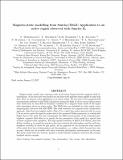Por favor, use este identificador para citar o enlazar a este item:
http://hdl.handle.net/10261/147545COMPARTIR / EXPORTAR:
 SHARE SHARE
 CORE
BASE CORE
BASE
|
|
| Visualizar otros formatos: MARC | Dublin Core | RDF | ORE | MODS | METS | DIDL | DATACITE | |

| Título: | Magneto-static modeling from Sunrise/IMaX: application to an active region observed with Sunrise II |
Autor: | Wiegelmann, T.; Toro, José Carlos del CSIC ORCID ; Orozco Suárez, David CSIC ORCID CVN; Knölker, M. | Palabras clave: | Sun: chromosphere Sun: corona Sun: magnetic fields Sun: photosphere |
Fecha de publicación: | 22-mar-2017 | Editor: | American Astronomical Society Institute of Physics (Great Britain) |
Citación: | Astrophysical Journal - Supplement Series 229(1): 18 (2017) | Resumen: | ©2017 The American Astronomical Society. All rights reserved.Magneto-static models may overcome some of the issues facing force-free magnetic field extrapolations. So far they have seen limited use and have faced problems when applied to quiet-Sun data. Here we present a first application to an active region. We use solar vector magnetic field measurements gathered by the IMaX polarimeter during the flight of the Sunrise balloon-borne solar observatory in 2013 June as boundary conditions for a magneto-static model of the higher solar atmosphere above an active region. The IMaX data are embedded in active region vector magnetograms observed with SDO/HMI. This work continues our magneto-static extrapolation approach, which was applied earlier to a quiet-Sun region observed with Sunrise I. In an active region the signal-to-noise-ratio in the measured Stokes parameters is considerably higher than in the quiet-Sun and consequently the IMaX measurements of the horizontal photospheric magnetic field allow us to specify the free parameters of the model in a special class of linear magneto-static equilibria. The high spatial resolution of IMaX (110–130 km, pixel size 40 km) enables us to model the non-force-free layer between the photosphere and the mid-chromosphere vertically by about 50 grid points. In our approach we can incorporate some aspects of the mixed beta layer of photosphere and chromosphere, e.g., taking a finite Lorentz force into account, which was not possible with lower-resolution photospheric measurements in the past. The linear model does not, however, permit us to model intrinsic nonlinear structures like strongly localized electric currents. | Descripción: | T. Wiegelmann et. al. | Versión del editor: | https://doi.org/10.3847/1538-4365/aa582f | URI: | http://hdl.handle.net/10261/147545 | DOI: | 10.3847/1538-4365/aa582f | ISSN: | 0067-0049 | E-ISSN: | 1538-4365 |
| Aparece en las colecciones: | (IAA) Artículos |
Ficheros en este ítem:
| Fichero | Descripción | Tamaño | Formato | |
|---|---|---|---|---|
| IAA_2017_ApJS_229_17.pdf | 1,5 MB | Adobe PDF |  Visualizar/Abrir |
CORE Recommender
SCOPUSTM
Citations
21
checked on 21-abr-2024
WEB OF SCIENCETM
Citations
20
checked on 24-feb-2024
Page view(s)
308
checked on 24-abr-2024
Download(s)
227
checked on 24-abr-2024
Google ScholarTM
Check
Altmetric
Altmetric
NOTA: Los ítems de Digital.CSIC están protegidos por copyright, con todos los derechos reservados, a menos que se indique lo contrario.
